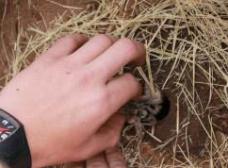Spider relocation project a great success!
A spider relocation project in Lephalale by the Exxaro Grootegeluk Medupi Expansion Project teams has shown positive and pro-mising success and is attracting the attention of a host of other organisations interested in the rehabilitation and enhancement of biodiversity.
Northern News reported on the project last year when baboon spiders were observed along the roads during the vegetation clearing phase for the construction of roads leading to the Medupi power station in March 2012. Suggestions were made to move the spiders to a safer area as they are long-living invertebrates protected under the National Environmental Management: Biodiversity Act.
Exxaro put the job of capturing the spiders out to tender and engaged Reptile Rescue’s Marius Koekemoer, a local resident of Lephalale with extensive knowledge of reptiles and spiders, (and moreover with a government permit to remove the spiders from the wild) to remove them from the site. Koekemoer worked with two research technicians, Bianca Smith and Roelien Jacobs, to capture the spiders over a period of three weeks. Overall they removed 175 individuals of the two species along the Nelson Mandela Road and another 376 along the Kuipersbult Road.
An 800ha portion in the south of the Manketti Game Reserve, just outside Lephalale, was identified as a suitable new habitat. The area was screened and a natural population of baboon spiders identified and used as a naturally occurring control population. A total of 60 spiders were also relocated on Eskom’s rehabilitated Matimba power station ash dump in order to test the results of the research project in action.
At the relocation sites, around 200 man-made burrows of different diameters were created in the ground to accommodate the baboon spiders. A steel cage manufactured by the central plate workshop team at Grootegeluk was fixed into the ground over each artificial burrow to prevent spiders from escaping until they had adopted the burrow, and to keep predators out.
Each burrow, for both the relocated and control populations was monitored weekly, directly after release, and monthly after the first three months.
“We said that we would be happy if over a period of one week, 50% accepted their new burrows, so we were absolutely thrilled with a 95% acceptance rate,” said Marius Fuls, Manketti Game Reserve research manager.
“Releasing them without a ready-made burrow is not very successful. They are usually eaten by predators such as baboons, mongooses, birds and other spiders before they can build a shelter for themselves. We also observed that the time of day of relocation is important: it seemed more successful to relocate the spiders in the first half of the day in order to give them time to settle before they become active at night.
“Construction company Basil Read heard about the project and brought a number of spiders they discovered while working on the Mokolo pipeline and BHP Billiton, has expressed interest in our project as well,” said Fuhls.
According to Exxaro’s ecologist, Koos Smit, the project enables the company to mitigate the impact of its operations. “The research findings indicate that these species can be relocated successfully to ensure the survival of individuals and populations. Entomologist Dr Dawid Jacobs is of the opinion that the relocation methods that have been tested will probably be applicable to most other baboon spider species as the two species that were relocated are the most common species,” he added.
Photos courtesy of Exxaro














0 Comments